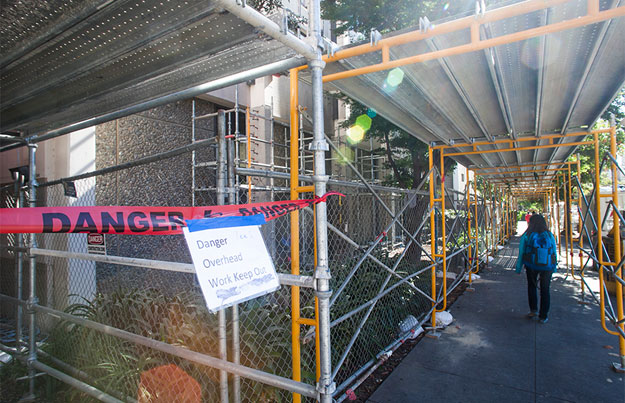Residence halls found to be below UC safety standards

BY JOSE HERNANDEZ | STAFF
An April inspection into the seismic safety levels of Units 1, 2 and 3 found four high-rise buildings in each residence hall complex to be below safety standards held by the University of California.
The buildings are rated between a IV and a V on the university’s scale for seismic safety, according to Christine Shaff, director of communications for UC Berkeley’s facilities services department. Those ratings imply a risk to life between “small” and “serious,” according to UC seismic safety policy.
Evaluations of the housing units in 1997 indicated that the high-rise buildings met the university’s standards. The goal of construction this summer, Shaff said, is to bring the residence halls to an acceptable rating of III.

Construction began on the high-rises — which do not include newer mini-suites — on May 19 and is scheduled to finish before fall residents begin to move in on Aug. 24. Exterior work, however, will continue through the fall semester.
The construction will cost $9.2 million for Unit 3, while Unit 1 and Unit 2 will each cost $8.8 million, according to Marty Takimoto, director of communications and marketing for the Residential and Student Service Programs, which oversees the residence halls. Only RSSP funds were used for the retrofitting.
“All our revenue comes from room and board and the rent students pay,” Takimoto said. “We use that revenue to fund projects like this, and we had this money in reserve.”
Takimoto said that the retrofitting is important in preserving the longevity of the buildings but that the seismic retrofit will also affect future plans to improve housing for students.
Some of these future plans include a major renovation of Unit 3, currently budgeted at $76.9 million for 2016-17, according to the University of California Capital Financial Plan for 2012-22. $23.1 million of the project is slated to come from auxiliary services like housing, according to the report.
“With this additional strengthening this summer, we will likely postpone any major renovation to Unit 3 for a while longer,” Takimoto said in an email.
After the inspection in April, plans were made to begin construction as soon as students moved out for the summer. Students were notified on April 30 that construction was planned, and fall 2013 residents were notified on May 29 that some exterior work will continue during the fall semester.
“We kind of lucked out,” Takimoto said. “We weren’t given an edict to do the construction right away — just as quickly as possible. We were able to make it happen quickly because there was time.”
The units have had seismic retrofitting before, which added cross bracing on the exterior of some buildings. High-rises in Units 1, 2 and 3 were each renovated between 1986 and 1996.
One of RSSP’s goals during construction has been to reduce the impact on residents, Takimoto said.
Students who would have otherwise used the units during the summer have already been reassigned to other residential halls on campus. Summer session students will live at Clark Kerr Campus, and CalSO students will stay in Bowles and Stern halls, Takimoto said.
Only the high-rise buildings are being retrofitted this summer. They include Cheney, Deutsch, Freeborn and Putnam halls in Unit 1; Cunningham, Davidson, Ehrman and Griffiths halls in Unit 2; and Ida Sproul, Norton, Priestley and Spens-Black Halls in Unit 3. The remaining halls, referred to as infill buildings, are newer and do not require retrofitting.
The seismic retrofitting project falls in line with the goals of UC Berkeley’s SAFER program, implemented in 1997 to address structurally unsafe buildings on campus. The high rises and Unit 3 were given a rating of “good” that same year, which is roughly equivalent to a III on the new UC scale.
Of the total square footage identified by SAFER as needing an upgrade, 60 percent has been completed or is in progress. Another 10 percent is scheduled to be strengthened by 2014.
[Source]: The Daily Californian


